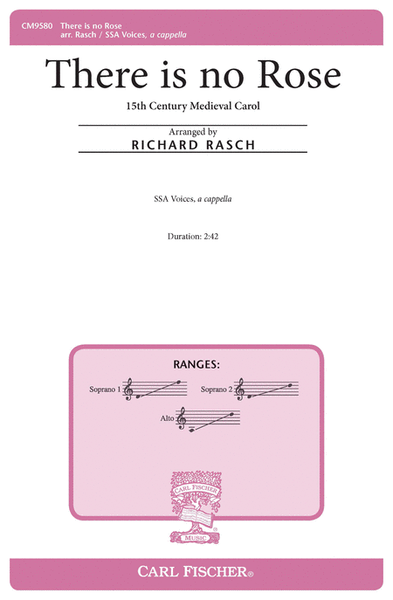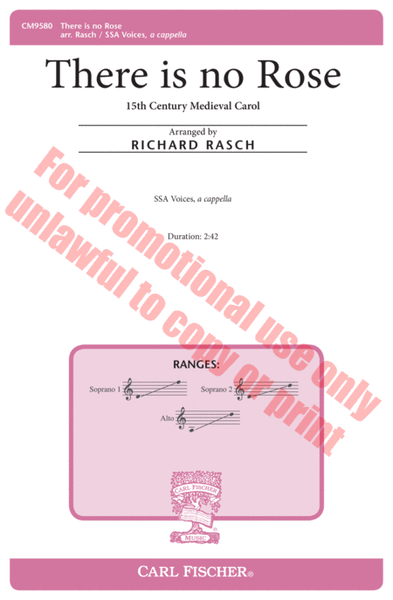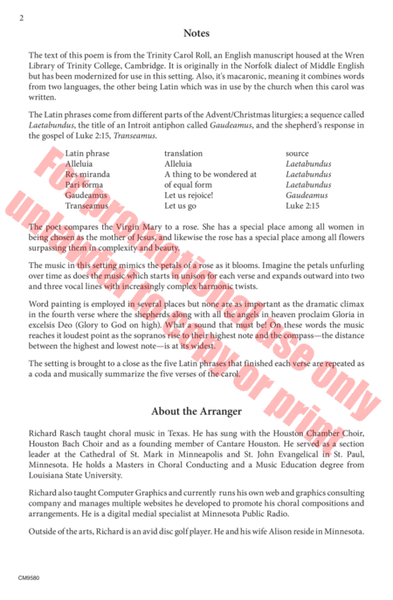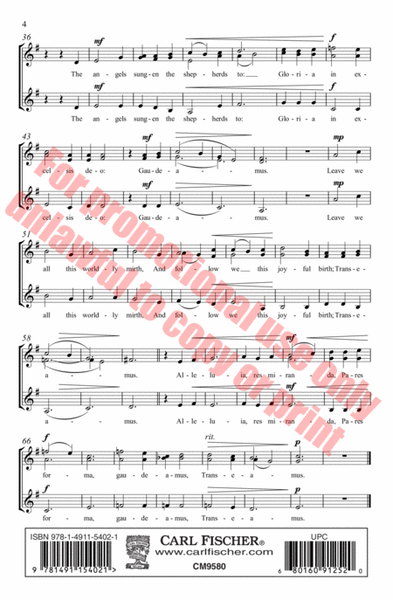There Is No Rose
-
Ships in 1 to 2 weeks
Details
- Instruments
- Ensembles
- Publishers
- Formats
- Item Types
- Usages
Description
SKU: CF.CM9580
Composed by Richard Rasch. Arranged by Richard Rasch. Fold. Performance Score. 4 pages. Duration 2 minutes, 42 seconds. Carl Fischer Music #CM9580. Published by Carl Fischer Music (CF.CM9580).ISBN 9781491154021. UPC: 680160912520. 6.875 x 10.5 inches. Key: D mixolydian. English, Latin. 15th Century Medieval Carol.
The text of this poem is from the Trinity Carol Roll, an English manuscript housed at the Wren Library of Trinity College, Cambridge. It is originally in the Norfolk dialect of Middle English but has been modernized for use in this setting. Also, it's macaronic, meaning it combines words from two languages, the other being Latin which was in use by the church when this carol was written. The Latin phrases come from different parts of the Advent/Christmas liturgies; a sequence called Laetabundus, the title of an Introit antiphon called Gaudeamus, and the shepherds response in the gospel of Luke 2:15, Transeamus. Latin phrase translation source Alleluia Alleluia Laetabundus Res miranda A thing to be wondered at Laetabundus Pari forma of equal form Laetabundus Gaudeamus Let us rejoice! Gaudeamus Transeamus Let us go Luke 2:15 The poet compares the Virgin Mary to a rose. She has a special place among all women in being chosen as the mother of Jesus, and likewise the rose has a special place among all flowers surpassing them in complexity and beauty. The music in this setting mimics the petals of a rose as it blooms. Imagine the petals unfurling over time as does the music which starts in unison for each verse and expands outward into two and three vocal lines with increasingly complex harmonic twists. Word painting is employed in several places but none are as important as the dramatic climax in the fourth verse where the shepherds along with all the angels in heaven proclaim Gloria in excelsis Deo (Glory to God on high). What a sound that must be! On these words the music reaches it loudest point as the sopranos rise to their highest note and the compassthe distance between the highest and lowest noteis at its widest. The setting is brought to a close as the five Latin phrases that finished each verse are repeated as a coda and musically summarize the five verses of the carol.
The text of this poem is from the Trinity Carol Roll, an English manuscript housed at the Wren Library of Trinity College, Cambridge. It is originally in the Norfolk dialect of Middle English but has been modernized for use in this setting. Also, it's macaronic, meaning it combines words from two languages, the other being Latin which was in use by the church when this carol was written. The Latin phrases come from different parts of the Advent/Christmas liturgies; a sequence called Laetabundus, the title of an Introit antiphon called Gaudeamus, and the shepherdas response in the gospel of Luke 2:15, Transeamus. Latin phraseA translation source Alleluia Alleluia Laetabundus Res miranda A thing to be wondered at Laetabundus Pari forma of equal form Laetabundus Gaudeamus Let us rejoice! Gaudeamus Transeamus Let us go Luke 2:15 The poet compares the Virgin Mary to a rose. She has a special place among all women in being chosen as the mother of Jesus, and likewise the rose has a special place among all flowers surpassing them in complexity and beauty. The music in this setting mimics the petals of a rose as it blooms. Imagine the petals unfurling over time as does the music which starts in unison for each verse and expands outward into two and three vocal lines with increasingly complex harmonic twists. Word painting is employed in several places but none are as important as the dramatic climax in the fourth verse where the shepherds along with all the angels in heaven proclaim Gloria in excelsis Deo (Glory to God on high). What a sound that must be! On these words the music reaches it loudest point as the sopranos rise to their highest note and the compassathe distance between the highest and lowest noteais at its widest. The setting is brought to a close as the five Latin phrases that finished each verse are repeated as a coda and musically summarize the five verses of the carol.
The text of this poem is from the Trinity Carol Roll, an English manuscript housed at the Wren Library of Trinity College, Cambridge. It is originally in the Norfolk dialect of Middle English but has been modernized for use in this setting. Also, it's macaronic, meaning it combines words from two languages, the other being Latin which was in use by the church when this carol was written. The Latin phrases come from different parts of the Advent/Christmas liturgies; a sequence called Laetabundus, the title of an Introit antiphon called Gaudeamus, and the shepherd's response in the gospel of Luke 2:15, Transeamus. Latin phrase translation source Alleluia Alleluia Laetabundus Res miranda A thing to be wondered at Laetabundus Pari forma of equal form Laetabundus Gaudeamus Let us rejoice! Gaudeamus Transeamus Let us go Luke 2:15 The poet compares the Virgin Mary to a rose. She has a special place among all women in being chosen as the mother of Jesus, and likewise the rose has a special place among all flowers surpassing them in complexity and beauty. The music in this setting mimics the petals of a rose as it blooms. Imagine the petals unfurling over time as does the music which starts in unison for each verse and expands outward into two and three vocal lines with increasingly complex harmonic twists. Word painting is employed in several places but none are as important as the dramatic climax in the fourth verse where the shepherds along with all the angels in heaven proclaim Gloria in excelsis Deo (Glory to God on high). What a sound that must be! On these words the music reaches it loudest point as the sopranos rise to their highest note and the compass--the distance between the highest and lowest note--is at its widest. The setting is brought to a close as the five Latin phrases that finished each verse are repeated as a coda and musically summarize the five verses of the carol.
The text of this poem is from the Trinity Carol Roll, an English manuscript housed at the Wren Library of Trinity College, Cambridge. It is originally in the Norfolk dialect of Middle English but has been modernized for use in this setting. Also, it's macaronic, meaning it combines words from two languages, the other being Latin which was in use by the church when this carol was written. The Latin phrases come from different parts of the Advent/Christmas liturgies; a sequence called Laetabundus, the title of an Introit antiphon called Gaudeamus, and the shepherd's response in the gospel of Luke 2:15, Transeamus. Latin phrase translation source Alleluia Alleluia Laetabundus Res miranda A thing to be wondered at Laetabundus Pares forma of equal form Laetabundus Gaudeamus Let us rejoice! Gaudeamus Transeamus Let us go Luke 2:15 The poet compares the Virgin Mary to a rose. She has a special place among all women in being chosen as the mother of Jesus, and likewise the rose has a special place among all flowers surpassing them in complexity and beauty. The music in this setting mimics the petals of a rose as it blooms. Imagine the petals unfurling over time as does the music which starts in unison for each verse and expands outward into two and three vocal lines with increasingly complex harmonic twists. Word painting is employed in several places but none are as important as the dramatic climax in the fourth verse where the shepherds along with all the angels in heaven proclaim Gloria in excelsis Deo (Glory to God on high). What a sound that must be! On these words the music reaches it loudest point as the sopranos rise to their highest note and the compass--the distance between the highest and lowest note--is at its widest. The setting is brought to a close as the five Latin phrases that finished each verse are repeated as a coda and musically summarize the five verses of the carol.
The text of this poem is from the Trinity Carol Roll, an English manuscript housed at the Wren Library of Trinity College, Cambridge. It is originally in the Norfolk dialect of Middle English but has been modernized for use in this setting. Also, it's macaronic, meaning it combines words from two languages, the other being Latin which was in use by the church when this carol was written.The Latin phrases come from different parts of the Advent/Christmas liturgies; a sequence called Laetabundus, the title of an Introit antiphon called Gaudeamus, and the shepherd’s response in the gospel of Luke 2:15, Transeamus.Latin phrase translation sourceAlleluia Alleluia LaetabundusRes miranda A thing to be wondered at LaetabundusPares forma of equal form LaetabundusGaudeamus Let us rejoice! GaudeamusTranseamus Let us go Luke 2:15The poet compares the Virgin Mary to a rose. She has a special place among all women in being chosen as the mother of Jesus, and likewise the rose has a special place among all flowers surpassing them in complexity and beauty.The music in this setting mimics the petals of a rose as it blooms. Imagine the petals unfurling over time as does the music which starts in unison for each verse and expands outward into two and three vocal lines with increasingly complex harmonic twists.Word painting is employed in several places but none are as important as the dramatic climax in the fourth verse where the shepherds along with all the angels in heaven proclaim Gloria in excelsis Deo (Glory to God on high). What a sound that must be! On these words the music reaches it loudest point as the sopranos rise to their highest note and the compass—the distance between the highest and lowest note—is at its widest.The setting is brought to a close as the five Latin phrases that finished each verse are repeated as a coda and musically summarize the five verses of the carol.





 Share
Share